HIPAA Compliance Checklist for 2025

Your design team loves Figma and honestly, who wouldn’t? Real-time collaboration, shared libraries, interactive prototypes… it feels like creativity finally got a workspace that doesn’t fight back. But while the canvas looks sleek, the license usage behind it usually doesn’t.
Somewhere between shared design files and entire teams hopping in and out of projects, Figma licenses tend to multiply. And that’s when design efficiency hits an unexpected slowdown. You’re not just paying for what’s needed but for what’s forgotten.
CloudEagle.ai steps in right there to clear the clutter that gets in creativity’s way. Application visibility, usage clarity, and automated rightsizing, all without slowing down your team’s momentum.
TL;DR
- Figma’s flexible model often leads to unused editor seats and duplicate accounts across teams.
- Inactive users and overlapping tools quietly increase costs without clear visibility.
- Departments purchase licenses independently, causing renewals and budgets to spiral.
- Teams face access delays while finance struggles to track true license utilization.
- CloudEagle.ai brings it all together by monitoring usage, reclaiming idle seats, and automating renewals.
Figma Is Powerful, But The Licensing Model Isn’t Always Clear
Teams adopt Figma because it feels simple. Everyone can jump in, collaborate, experiment, and iterate. But the moment you look at the pricing page, it suddenly feels like you’re reading a menu where every dish requires a decoder.
Roles, file permissions, shared libraries, editor vs. viewer access… and the moment one person clicks “Edit,” the bill changes shape.
- Editors vs. Viewers: Sounds simple, but one wrong click turns a viewer into a paid editor.
- Shared Team Libraries: great for collaboration, surprisingly easy to mis-assign access to.
- Guest Access: helpful, but when does a “guest” quietly become a “seat you pay for”?
It’s not that the pricing is “bad.” It’s just that it evolves with usage, which means costs grow when no one is looking. Creative teams explore freely; finance teams discover the bill later.
- Reality: The more collaborative your workflow becomes, the faster license sprawl grows.
- Problem: Most teams don’t realize it until renewal season, when the invoice looks… different.
The Invisible Spend Drains That Creep In Over Time
No one plans to overspend on Figma. It just… happens slowly. A new project kicks off, someone needs edit access “for just a week,” or a few shared libraries get published. And before you know it, your license count has grown like a houseplant you forgot to prune.
1. Files and Permissions That Go Unreviewed for Months
You check in on your Figma workspace and everything seems fine. But behind the scenes, access control is creeping. A designer leaves, someone shifts roles, a guest collaborator turns regular, and no one pauses to ask: Who’s editing this now?
- Old Edits, New Hands: Files updated by someone who’s no longer on the project still grant full edit rights.
- Permission Inertia: “Set it and forget it” permissions keep rolling even when duties change.
- License Drain: Edit seats linked to these files continue to count—even when the original user is gone.
One study by Nexthink found that up to 53% of licensed applications sit idle or under-used, costing organizations significant waste.
- Audit Surprise: Come renewal season, you have to scramble through file logs and access records.
- Hidden Risk: Dormant edit access isn’t just wasted cost, it’s a security vulnerability.
2. Overlapping Design Tools Used by the Same Team
Sometimes teams don’t choose multiple design tools, they just end up with them. A UI designer prefers Figma and a product manager uses Miro for wireframes because “it’s what they know.” Each tool solves a slightly different need, and no one wants to disrupt the flow. So the stack grows quietly.
From the team’s perspective:
It feels harmless. Everyone is just doing their work. Switching tools feels like slowing down when deadlines are tight. The goal is to ship, not reorganize workflows.
From finance or IT’s perspective:
It looks like a duplicate spend. Two tools solving the same problem. Licenses piling up. Renewal dates are scattered, so as to spend management.
Naval, Founder & CEO, AngelList, put it simply:
“We didn’t decide to have three design platforms. It just kind of happened one project at a time.”
As a result, it leads to:
- Multiple edit seats across platforms for the same user.
- Design handoffs spread across incompatible systems.
- Two or more subscriptions renewing without anyone realizing they overlap.
And because everything still works, no one feels the urgency to audit it, until budget time arrives and someone asks, “Why are we paying for all three?”
3. Paying For Convenience Instead of Utilization
There’s this quiet moment teams never really talk about. The moment when convenience wins over intention. Someone needs a quick edit, someone else wants a new file space, and the fastest path becomes, “Just add another license, we’ll sort it out later.”
Later never comes.
People move on to new projects. Designers switch teams. Priorities shift. But those underutilized licenses stay active, humming quietly in the background like appliances left plugged in. No one questions them, because no one feels directly responsible for them.
And that’s how convenience turns into cost. Not dramatic, not malicious, just gradual, almost invisible. A few extra seats here, a few “temporary” upgrades there. It’s not a waste you notice. It's a waste you inherit.
Collaboration Should Feel Smooth, Not Expensive or Chaotic
Teams join forces in Figma expecting seamless design flow, but hidden license issues can make collaboration feel like navigating a maze. Costs quietly escalate, files get duplicated, and accountability for usage fades into ambiguity.
1. Designers Should Create, Not Manage Seat Allocations
Sometimes designers don’t even realize they’re responsible for license management. Someone new joins, someone else moves to another team, a freelancer needs temporary access. Slack pings, “Hey, can you add me to Figma?” Suddenly the designer is the accidental license admin.
What Designers Think?
They’re trying to get a flow going. They’ve got wireframes to revise, a review call in 30 minutes, maybe a prototype that keeps breaking. Stopping to track who has an Editor seat versus Viewer feels like stepping out of the creative lane into operational traffic.
What About the Enterprise?
That’s time slipping away. Small interruptions spread across weeks. Designers doing administrative work is an invisible cost, not dramatic enough to show up on dashboards, but noticeable when deadlines stretch.
Michael Riddering, Design Lead at Figma, once mentioned something similar in an interview:
“Designers work best when they can stay in the creative mindset. Constant context switching is where momentum gets lost.”
And when momentum breaks:
- Creative work takes longer than necessary.
- Collaboration feels like it has friction where it shouldn’t.
- Teams assume they need “more seats” when they really need clear ownership.
The issue isn’t ability but more like it’s attention. Designers aren’t paid to manage tools. They’re paid to make things others can’t.
2. Managers Need Clear Visibility, Not Guesswork
Managers expect clarity: who’s using our Figma licenses, how many seats are active, what are we really paying for? Unfortunately, that’s not the case every time.
Instead, they get spreadsheets with gaps, outdated reports, and a sense that budget-handcuffs are growing tighter while visibility shrinks.
- Missing usage data: Licenses are assigned, but no one can show the actual editor activity.
- Renewals on autopilot: Managers rely on renewal reminders instead of seeing current consumption.
- Decisions by hunch: “Looks like we need more seats” becomes the plan without concrete data.
A Forbes survey found that 53% of IT teams struggle with visibility over their software estate, making informed license decisions nearly impossible.
- Reactive rather than proactive: Managers wait for invoices to arrive before they discover issues.
- Budget surprises: Costs spike during renewals because the “guess” turned into real spend.
3. Finance Needs Predictable Billing, Not Surprises
Finance teams don’t need Figma to be cheap but more predictable. But Figma renewals often feel like a reveal rather than a review. Costs shift as teams add editors mid-project, freelance seats never get removed, and usage patterns fluctuate faster than finance gets updates.
So when renewal hits, the number on the invoice feels like it came out of nowhere.
- Editor seats increase silently during peak collaboration periods, then never decrease afterward.
- Shared or temporary access stays active, turning short-term needs into long-term cost.
- No clear mapping between team usage and actual license spend, making forecasting a guessing game.
And because finance has to approve budgets before they understand how the tool is being used, it turns planning into negotiation. Instead of Figma being a smooth part of collaboration, it becomes a recurring conversation that no one has enough visibility to solve.
CloudEagle.ai Brings Efficiency Back to Your Design Stack
Managing Figma licenses across multiple SSO logs, usage reports, and invoices often turns chaotic. Spreadsheets may track only a few core applications, leaving many others completely unmonitored.
This fragmented method results in unnecessary spending, compliance risks, and missed opportunities for optimization.

CloudEagle.ai delivers a centralized, real-time overview of all Figma licensing and spending. It automates tracking, usage analytics, and renewals, transforming a fragmented, manual process into a structured, data-driven workflow.
1. Seamless Figma Admin Console Integration
Manually handling Figma licenses is slow, error-prone, and frustrating. Building spreadsheets can take weeks, and by the time they’re ready, data is often outdated, leaving IT teams with incomplete insights on subscriptions, usage, and Figma pricing plans.
Current Process
Organizations often depend on spreadsheets and disconnected systems to track renewals, license counts, and user activity. This approach fragments data, and updates frequently become outdated before review.
Pain Points
Manual entry and delayed updates lead to errors and blind spots in software spend visibility. IT and finance teams lack accurate, real-time insights.
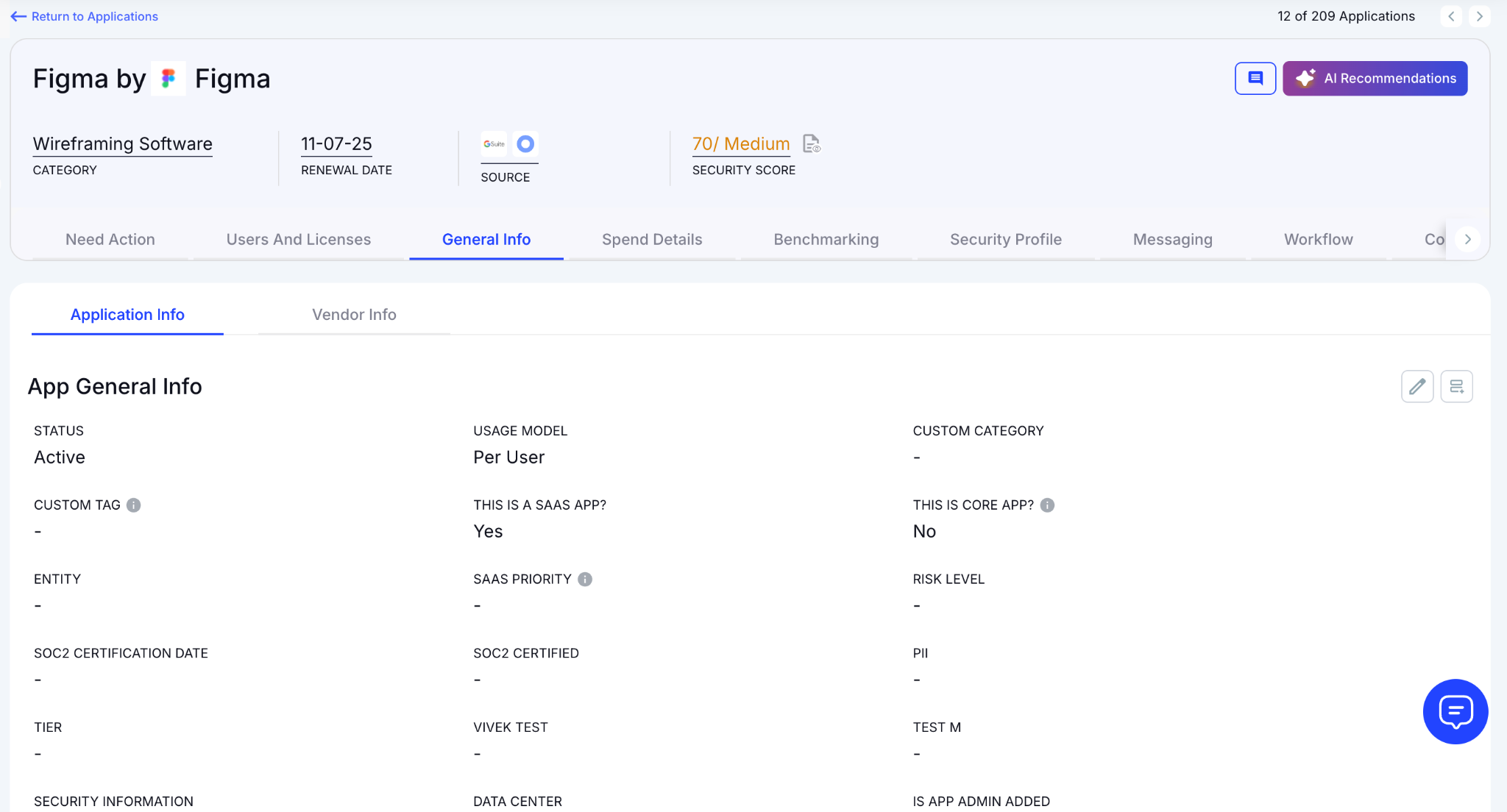
How We Do It
CloudEagle.ai aggregates vendor spend, usage data, and AI metadata extraction from all connected systems in real time. Renewal dates, costs, and usage are displayed side by side for easy analysis.
Why We Are Better
Onboarding takes only a few days. With over 500 integrations and AI-driven metadata extraction, CloudEagle.ai centralizes all license data, ensuring it remains accurate, reliable, and up to date.
2. Real-Time Usage Analytics & Shadow IT Detection
Without centralized oversight, Figma license management and duplicate apps can spiral out of control. Shadow IT often goes unnoticed, making it difficult for IT teams to spot redundant applications.
Current Process
Teams sometimes purchase duplicate applications through credit cards or free trials, which quietly convert into paid subscriptions. Detecting these overlaps manually is challenging.
Pain Points
Shadow IT leads to untracked Figma pricing and potential security issues. Manually identifying duplicates is labor-intensive and often misses overlapping applications.

How We Do It
CloudEagle.ai uses AI to automatically detect duplicate and overlapping applications while tracking feature-level usage. Shadow apps are flagged instantly.
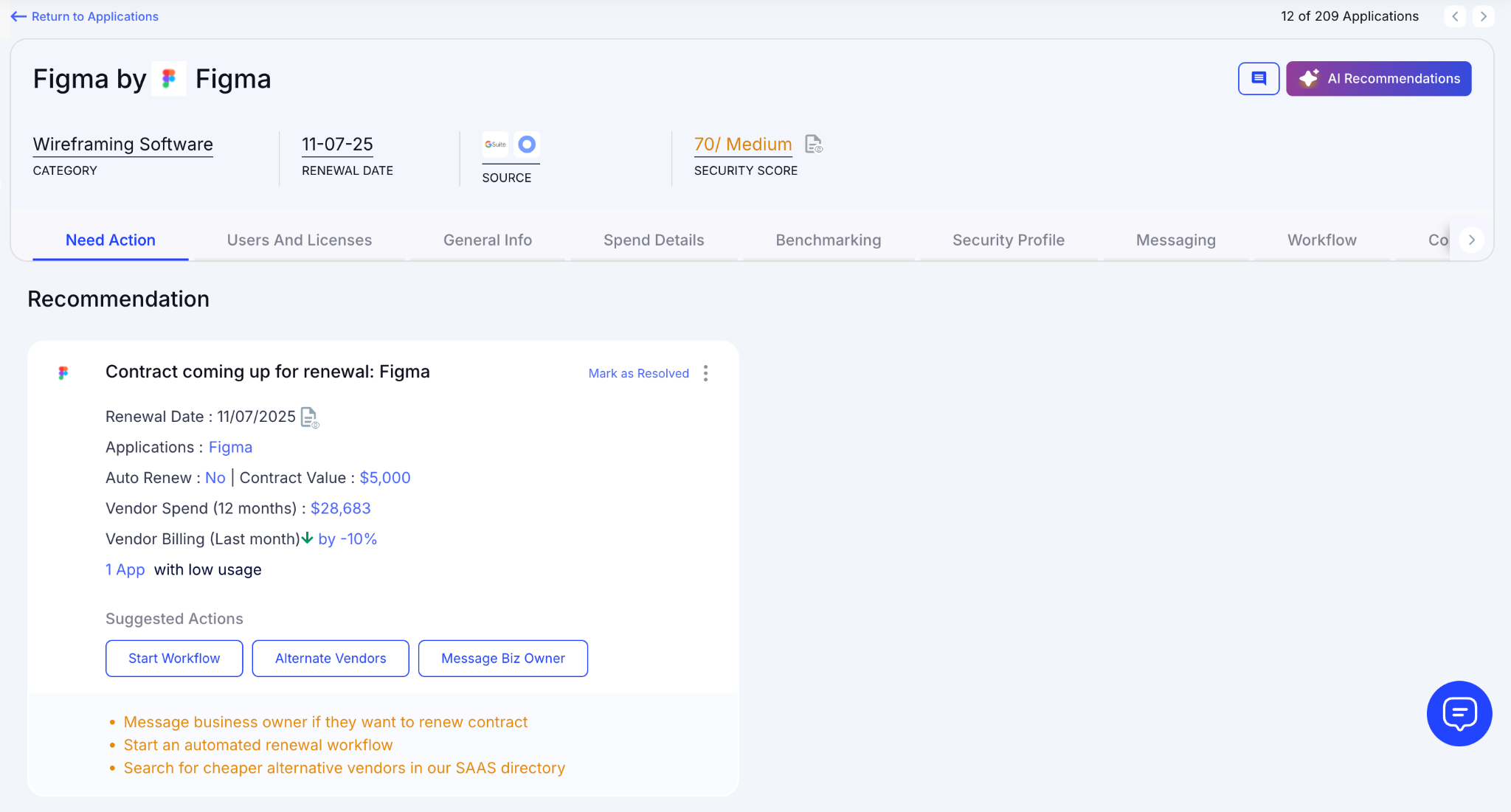
Why We Are Better
Our AI evaluates functionality, not just app names. IT teams can automatically email users, trigger workflows, or create ITSM tickets to reclaim licenses and reduce risks.
3. Centralized License Management
Managing Figma licenses across multiple teams can feel overwhelming. Many enterprises rely on spreadsheets to track top applications while manually consolidating SSO logs, usage, and contract data.
Current Process
Most organizations manage only core apps in spreadsheets, combining SSO logs, feature usage, and contracts manually, slowing updates and accuracy.
Pain Points
Unmonitored applications waste budgets, and license reassignment rarely happens. Renewal tracking is inconsistent, resulting in missed cost savings.
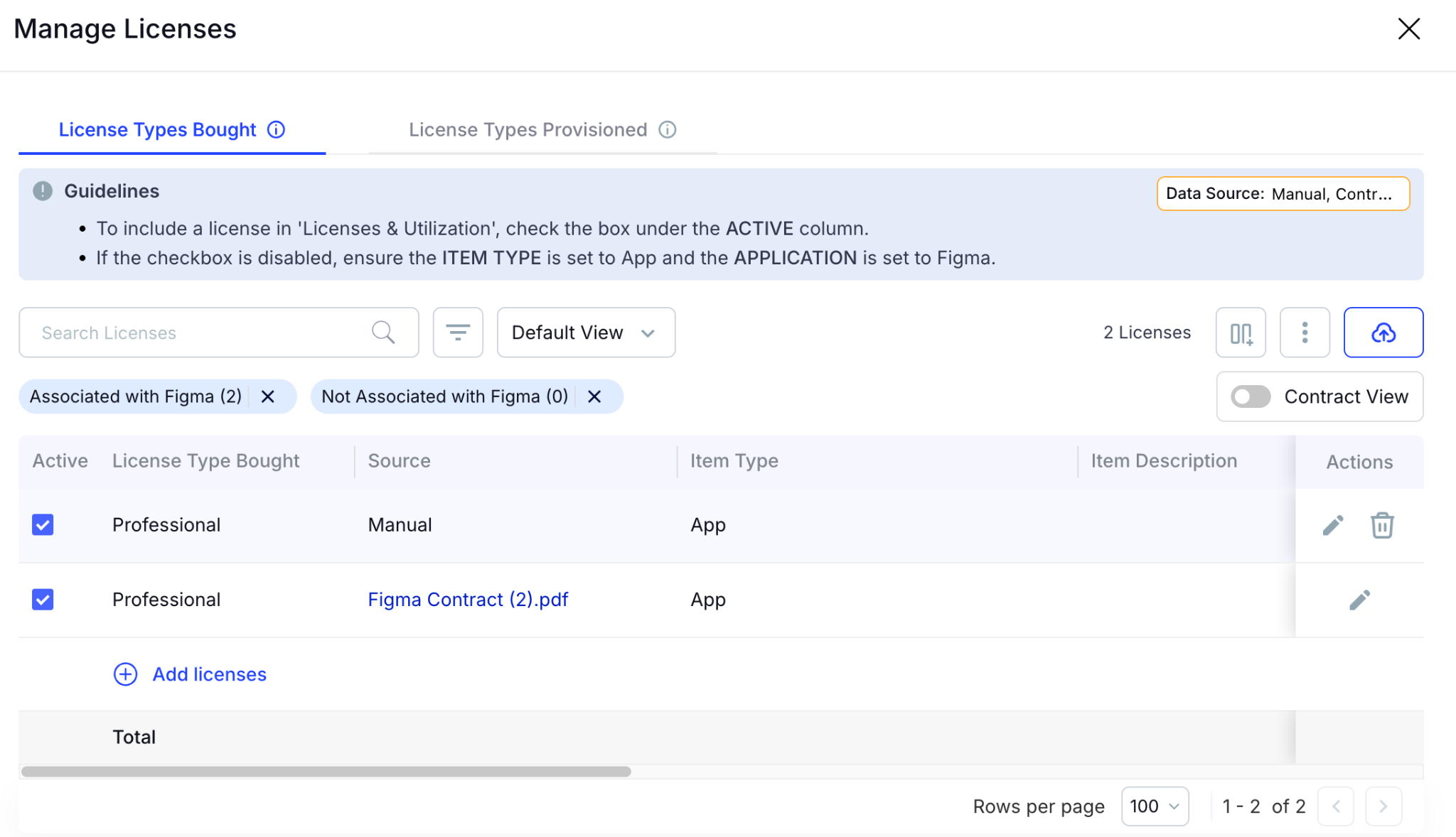
How We Do It
CloudEagle.ai centralizes license management on a single platform. Nightly syncs consolidate IDP, contract, and connector data, offering real-time visibility into usage.
Why We Are Better
Automatic updates correlate purchased licenses, users, and feature usage across all apps. Teams can filter by license type and make fast, data-backed decisions.
4. Automated License Harvesting
Unused Figma licenses silently inflate costs, yet IT teams often lack a systematic way to reclaim them. Manually tracking usage and sending weekly emails to hundreds of users is tedious, error-prone, and time-consuming.
Current Process
IT teams email inactive users manually and update spreadsheets, making the process slow, repetitive, and often skipped.
Pain Points
Inactive licenses remain active, draining budgets and increasing SaaS security risks. Manual reclamation does not scale efficiently.

How We Do It
CloudEagle.ai automates license harvesting. Weekly workflows detect inactivity, notify users, and reclaim or downgrade licenses based on usage.
Why We Are Better
Automations run daily or weekly via Okta or Microsoft AD. Licenses are reclaimed instantly, reducing waste, saving time, and maximizing utilization.
5. License Price Benchmarking
CloudEagle.ai’s benchmarking feature enables organizations to secure the best value during license renewals. By comparing contracts against industry standards, enterprises can negotiate competitive rates and avoid overpaying.
Current Process
Procurement teams rely on vendor quotes or outdated deals. Peer comparisons are limited and often fail to reflect real market prices.
Pain Points
Lack of accurate data hinders negotiations, leading to overpayment or unfavorable contract terms.
How We Do It
CloudEagle.ai provides real-time price benchmarks, historical trends, and Figma pricing guide to support informed, data-driven negotiation strategies.
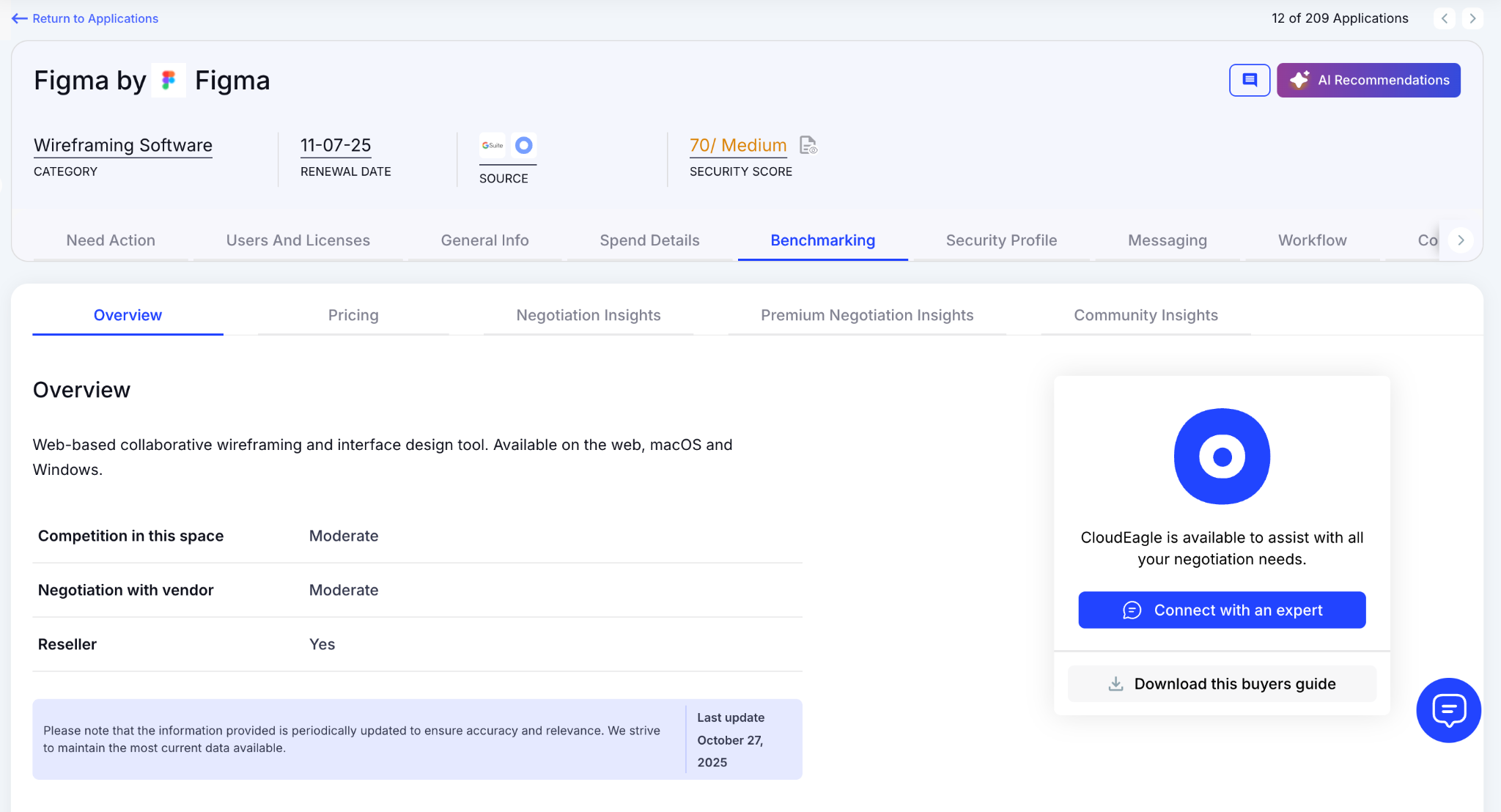
Why We Are Better
Figma pricing is detailed by SKU, license tier, and quantity, alongside key negotiation levers, ensuring renewals reflect actual market value.
6. Proactive Renewal Management
CloudEagle.ai supports renewal management with automated workflows triggered by contract dates. From approvals to adjusting Figma licensing counts, it prevents accidental auto-renewals and streamlines the process.
Current Process
Renewals are tracked through spreadsheets and long email chains. Approvals are slow, and auto-renewals are often overlooked.
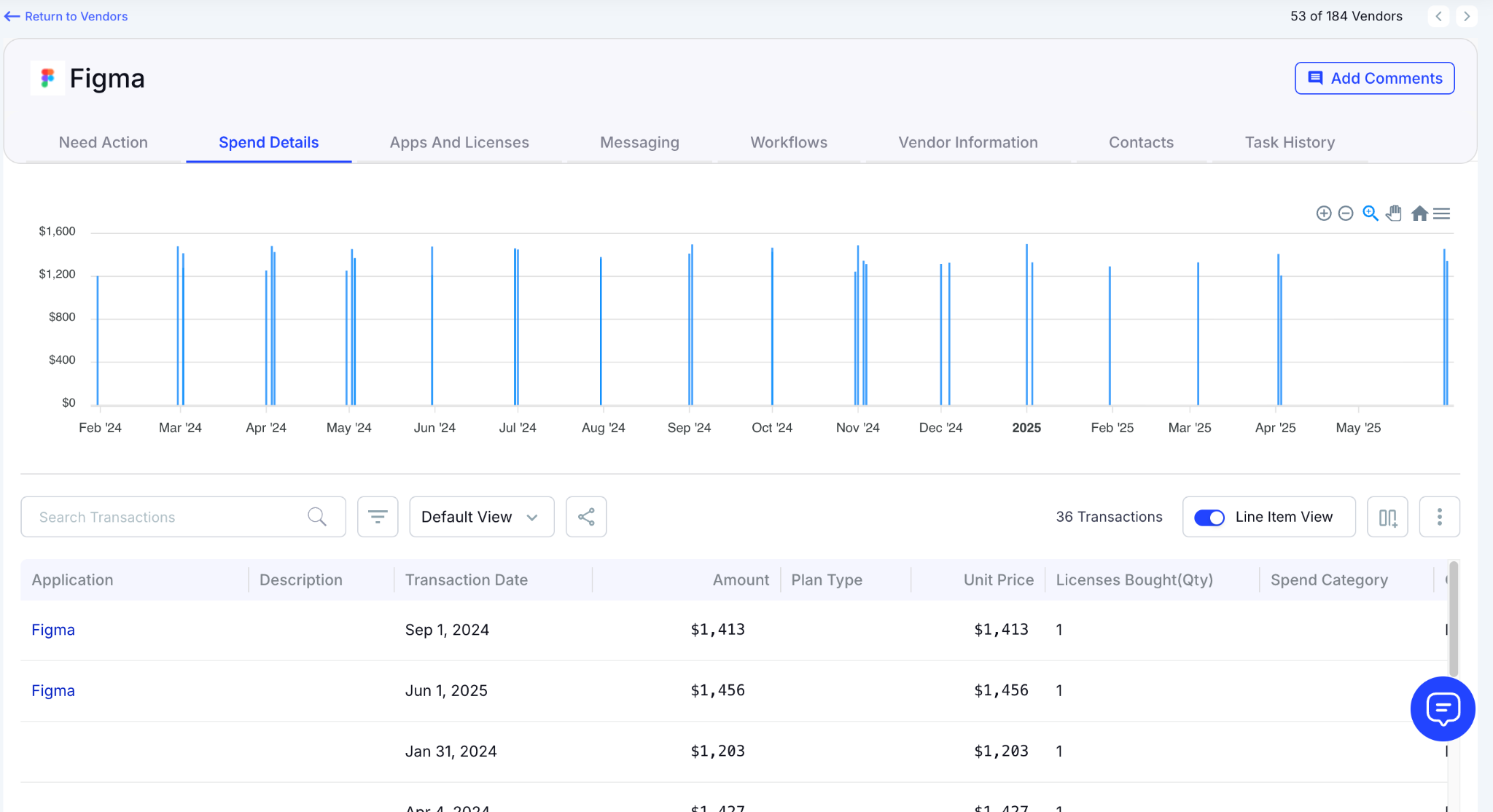
How We Do It
CloudEagle.ai generates a renewal calendar using AI-extracted metadata or integrates with CLMs like Ironclad, Figma, or Zip. Renewal workflows trigger 90 days before the notice period, assigning tasks to finance, legal, and business owners.
Why We Are Better
Teams receive alerts with usage insights, price benchmarks, and alternative options. Approvals are tracked automatically, preventing missed renewals and unnecessary spending.
7. Leverage Vendor Dashboards
CloudEagle.ai provides vendor dashboards for a complete view of Figma subscription data. Teams can track Figma licensing usage, renewal dates, and spending patterns to make data-driven decisions.
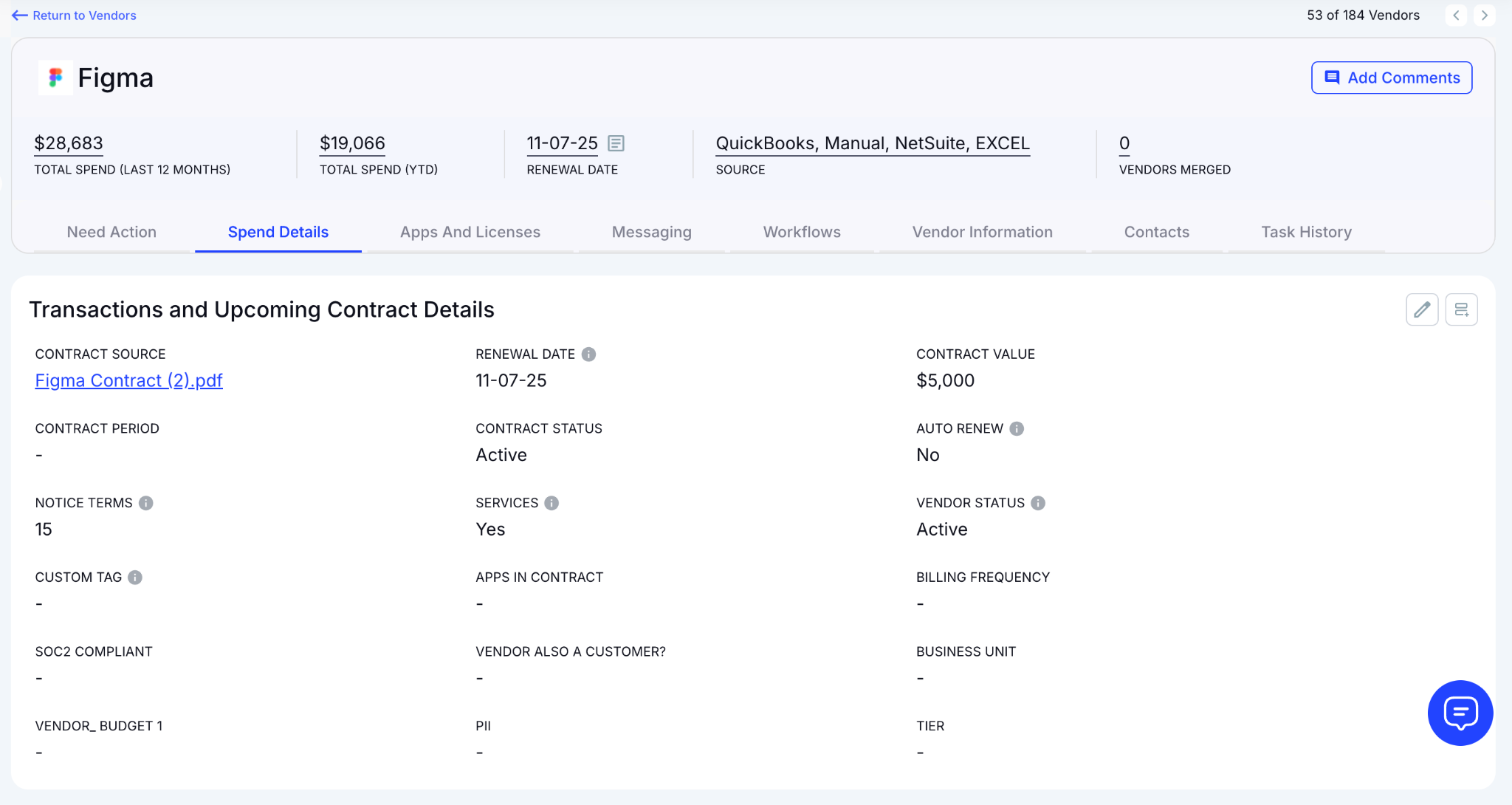
These dashboards highlight overspending and unused licenses, simplifying reclamation. They also reveal usage trends, helping organizations proactively adjust subscriptions and optimize Figma costs.
8. Simplified App Access Management
CloudEagle.ai streamlines Figma access by allowing employees to request licenses directly through the platform or Slack, eliminating long email chains and manual steps. Managers can review and approve requests in real time, ensuring prompt access.
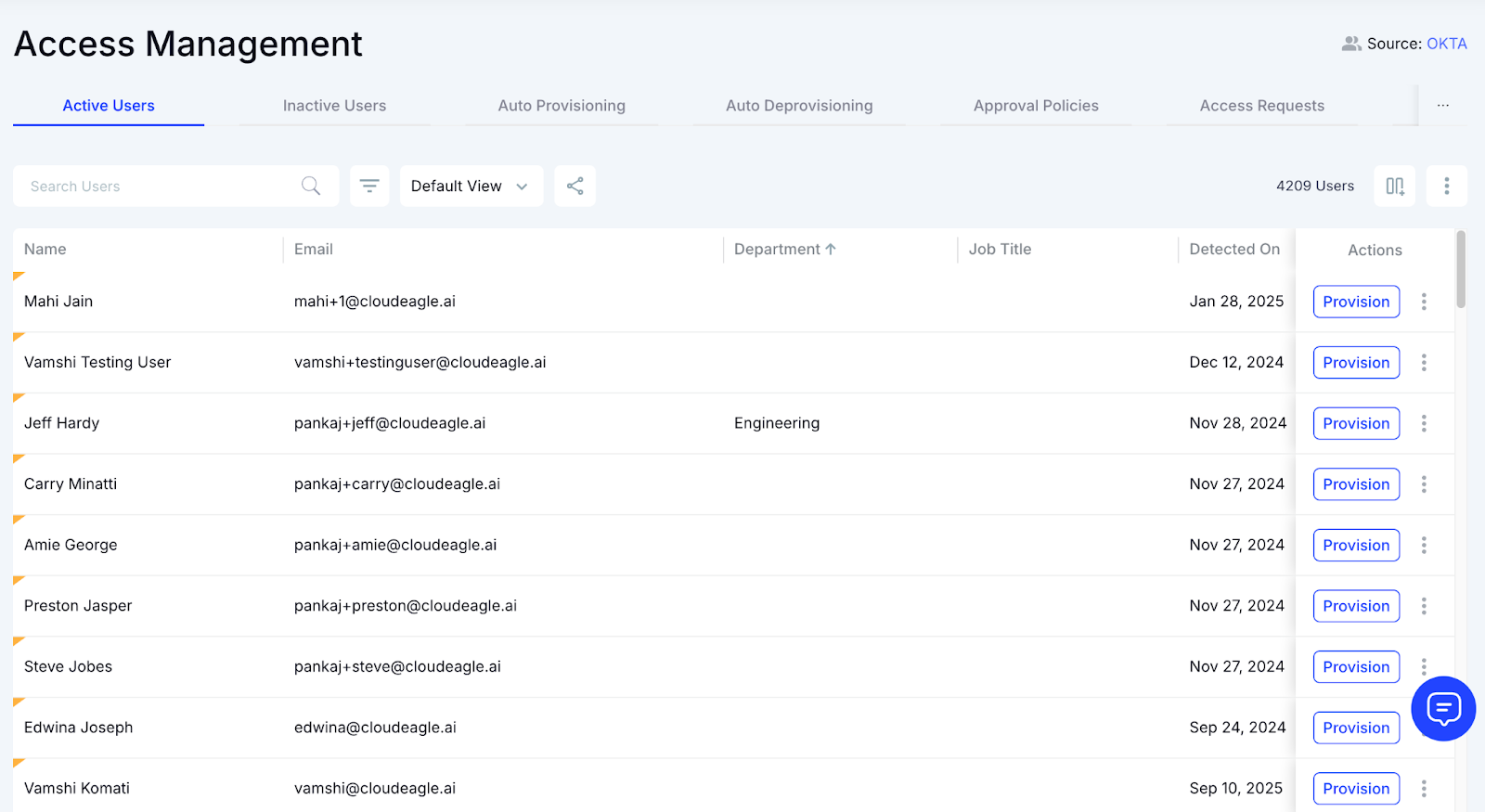
This method guarantees employees receive correct licenses without delays and removes approval bottlenecks. Each request is logged for transparency and compliance, making access management efficient while reducing administrative workload.
Conclusion
Figma is a great tool. That part was never in question. The real issue is everything around it, seats added in a hurry, projects that end without someone cleaning up access, overlapping tools that no one remembers choosing, and a renewal cycle that shows up faster than the system catches up.
CloudEagle.ai just makes that part easier. It takes what’s already happening across your organization and gives it shape, so the work can continue, but with a bit more clarity, a bit less waste, and a workflow that feels like it fits the way your team actually collaborates.
FAQs
1. Can I use Figma free for commercial use?
Yes, you can. Figma’s free plan allows commercial projects. The limitation isn’t usage rights, it’s seat and feature caps. If your team grows or needs advanced collaboration, that’s when you’ll need a paid tier.
2. How many people can use one Figma account?
One account = one individual. But you can invite others to the same workspace. Viewers are free. Editors require paid seats. If multiple people are logging in with the same account, it becomes messy fast, especially for security and version control.
3. Is Figma 100% free?
Not exactly. The Starter plan is free and surprisingly capable for small teams or solo work. But the moment you need multiple editors, shared libraries, or admin controls, you move into paid plans. So: free to begin, not free to scale.
4. Is Figma harder than Canva?
It depends on what you’re doing. Canva is quicker for ready-made visuals. Figma is built for structured design systems, collaboration, and product-level work. So Canva is easier to start with, but Figma offers more depth once workflows mature.
5. Can I sell designs created in Figma?
Yes, absolutely. You own the work you create. Many designers sell Figma UI kits, templates, and brand assets. Just keep an eye on any third-party assets used, those may have their own licensing terms.

%201.svg)









.avif)




.avif)
.avif)




.png)









